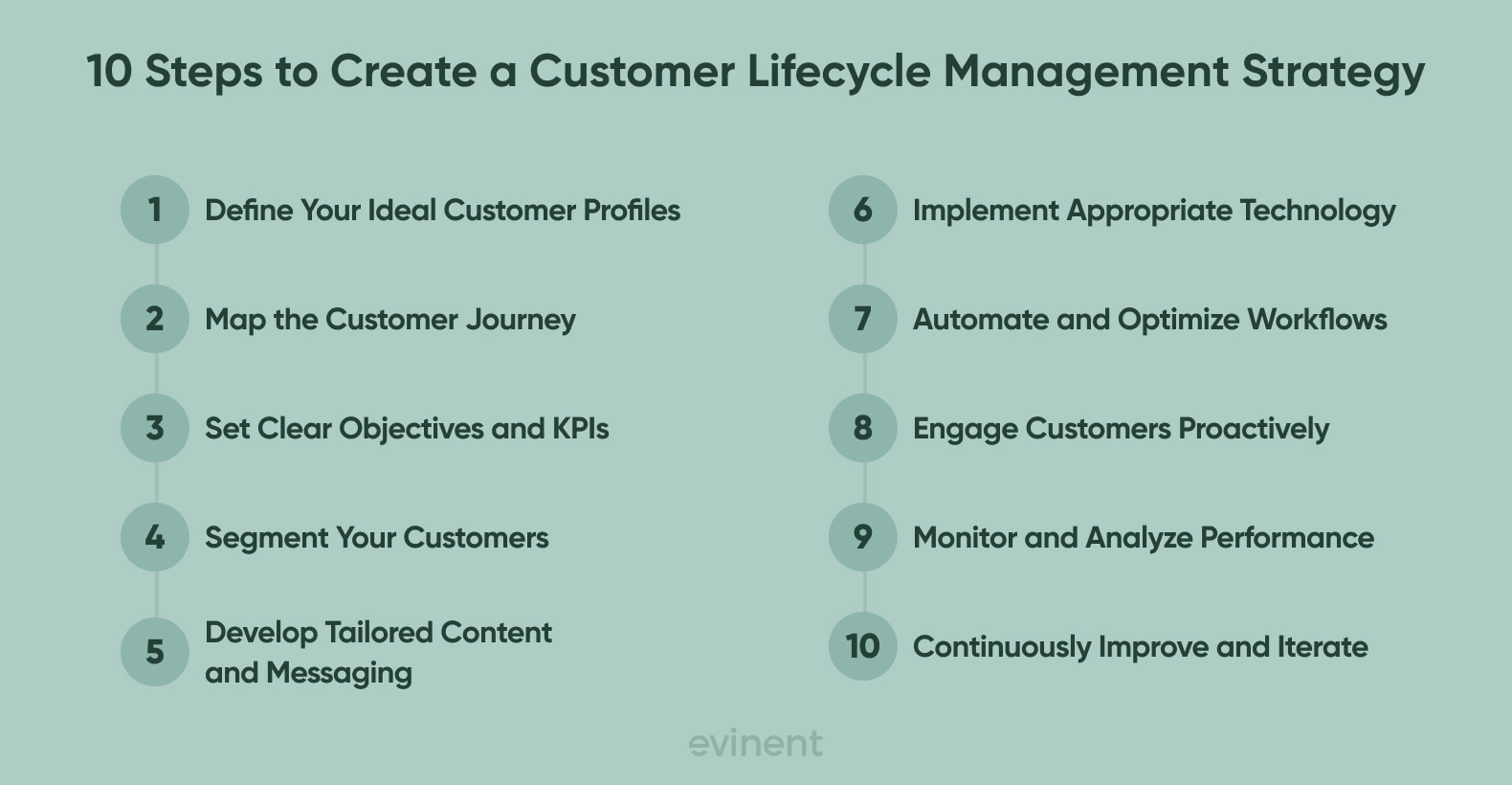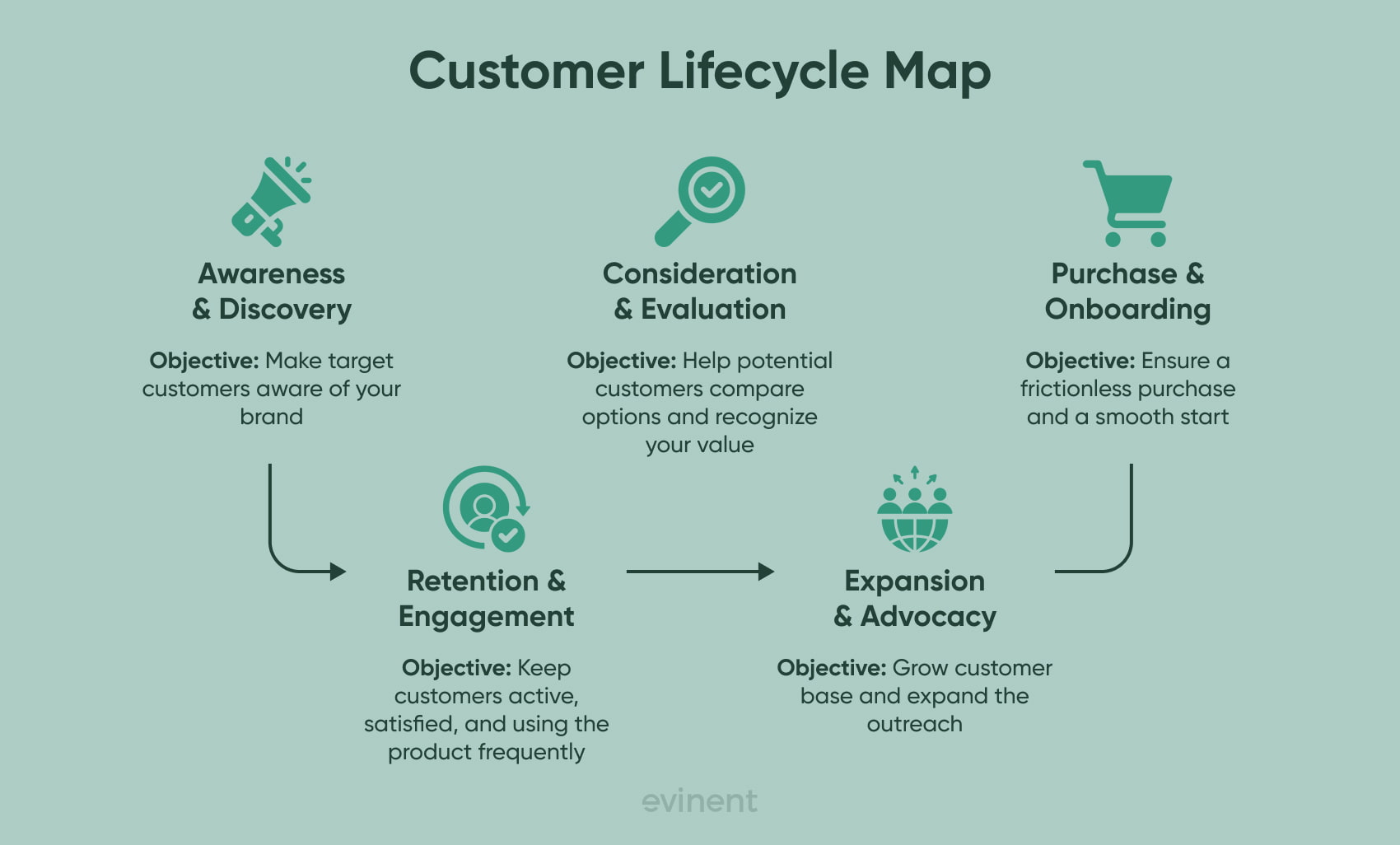What is Customer Lifecycle Management?
Customer Lifecycle Management (CLM) is a high-level plan for overseeing the interactions a customer has with your company - starting with the first point of contact and going through the entire buying process to repeat purchases and customer loyalty over time. CLM's purpose is, however, not only to get customers on board but to establish a constructive relationship that provides advantages to both parties.
In this article, we’ll explore how businesses can use CLM to:
gain deeper insights into their customers,
optimize each stage of the customer journey,
boost retention and loyalty,
and ultimately drive higher profitability.
We will discuss what is customer life cycle is, the best practices, detailed strategies, important lifecycle stages, and the distinction between CLM and CRM, which will provide you with a complete resource to efficiently implement CLM in your company.
Best Practices in Customer Lifecycle Management
The efficient handling of the customer lifecycle is essentially the establishment of a trouble-free and qualifying pathway through which a customer is nurtured into a long-lasting relationship. The companies that fully commit to the customer lifecycle management process can utilize customer data, create tailored customer experiences, and incorporate intelligent technology solutions, all with the end result of a customer journey that moves a prospect from initial contact to brand loyalty and beyond. Here are five meaningful best practices and their thorough explanations:
1. Organize and centralize customer data
Effective CLM starts with having a complete and unified view of your customers. Collect data from all touchpoints — sales interactions, website behavior, email engagement, social media activity, and customer service life cycle records — and store it in a central system. Centralized data allows teams to segment customers accurately, anticipate needs, and personalize communications. For example, a retail company can identify repeat buyers and target them with loyalty rewards or special promotions based on past purchases. It also prevents information silos, ensuring that every department works with the same accurate data.
2. Personalize the customer experience
Firstly, personalization is not just about using the customer's name. Data obtained from customers should be used to create offers, recommendations, and messages that match the likes and stage of the customer's lifecycle. For example, an e-commerce company may send out an abandoned cart email along with product suggestions that align with the customer's previous browsing activities. At the same time, a SaaS provider can facilitate account usage-based tutorials. Interaction with personalized experiences is positive as it leads to more trust and higher chances of turning customers into buyers since they get to feel recognized and valued.
3. Integrate technology across channels
Whether online, in-store, or through customer support, customers look for a flawless interaction at every point of contact. Synchronizing customer life cycle in crm, marketing automation, analytics instruments, and service platforms allows for a certain flow and saves time. Just imagine, a customer support representative who can get the full picture of a client's last purchase and all communications with the press of a button. Such integration of different communication channels helps internal operations become more efficient, quicker reaction times are possible as well, and employees are no longer burdened with doing the same work repeatedly.
4. Measure and analyze performance continuously
Continuous monitoring is key to refining CLM strategies. Track metrics such as customer acquisition cost (CAC), customer lifetime value (CLV), churn rate, engagement scores, and NPS (Net Promoter Score). Analyzing these metrics helps identify bottlenecks in the customer journey, underperforming campaigns, or segments with low retention. For example, if analytics reveal that a specific customer segment frequently abandons the checkout process, businesses can redesign the purchase flow or introduce targeted incentives to improve conversion. Data-driven insights allow companies to make smarter decisions and optimize lifecycle strategies in real time.
5. Foster proactive communication and support
Proactive engagement demonstrates that you care about your customers’ experience even before problems arise. This includes sending follow-up emails, personalized reminders, educational content, and satisfaction surveys. For example, a subscription service might customers about upcoming renewals, provide helpful usage tips, or offer tailored upgrades. Proactive support prevents issues from escalating, increases customer satisfaction, and reinforces loyalty. Over time, it encourages customers to become advocates for your brand, sharing positive experiences and driving referrals.
Such good procedures would essentially guarantee that the customer's stages are handled methodically. By using a more centralized data system, creating more personalized experiences, integrating technology, evaluating performance, and being more proactive in communication, companies not only get better customer satisfaction but also move towards sustainable growth. Customer lifecycle management as a looped, interactive scenario empowers organizations to harness customer loyalty to increase customer retention and profitability.
10 Steps to Сreate a Customer Lifecycle Management Strategy
The development of a winning Customer Lifecycle Management (CLM) plan should take careful consideration, with the step-by-step approach being the highlight of the plan. The whole process, from understanding customer profiles to journey mapping and employing technology, facilitates the organization in maximizing customer interaction, holding the customer base, and maintaining their loyalty in the long run. Here are ten stages that serve as an all-inclusive guide to creating an efficient customer lifecycle strategy:

1. Define Your Ideal Customer Profiles
Start by identifying your target customers and creating detailed profiles, including demographics, behaviors, preferences, and pain points. Understanding who your customers are helps tailor messaging, offers, and support to meet their needs. For example, a B2B software company might differentiate between small startups and enterprise clients, offering customized onboarding for each segment.
2. Map the Customer Journey
Mapping the customer journey in detail from the stage of first awareness to post-purchase engagement is vital. This exercise involves the identification of the touchpoints at which customers come in contact with your brand. Such occasions might include social media interactions, website visits, customer support, and email campaigns. Understanding the journey visually can reveal not only places where there might be gaps and inconveniences but also where there could be potential to improve the experience of the customer at any given stage.
3. Set Clear Objectives and KPIs
Start your customer lifecycle management strategy off with some measurable objectives. For instance, you can set targets for increasing customer retention, raising average order value, or enhancing Net Promoter Score (NPS). KPIs should be established to follow up on the progress made and guarantee that each work program leads to the general company goals. Transparent objectives facilitate decision-making and provide a way to evaluate achievements.
4. Segment Your Customers
Divide your customer base into meaningful segments based on behavior, lifecycle stage, or value. Segmentation allows you to deliver targeted marketing campaigns and personalized experiences that resonate with each group. For instance, frequent buyers might receive loyalty rewards, while new customers get onboarding guides and special offers.
5. Develop Tailored Content and Messaging
Develop content and messaging that are specifically designed for each segment and stage of the customer lifecycle framework. The content may consist of informational materials, special offers, reminders, or even a few lines of conversation. Custom messaging often results in higher engagement levels and creates a positive reputation with customers as they feel that they have been recognized and thus, their needs have been met.
6. Implement Appropriate Technology
Pick and combine the technologies that will help you implement your CLM plan, for instance, crm life cycle, marketing automation platforms, analytics tools, and customer support software. An effective technological infrastructure guarantees smooth data collection, tailor-made communication, and efficient activities throughout the customer journey.
7. Automate and Optimize Workflows
Automate repetitive tasks like email follow-ups, reminders, and notifications to ensure consistency and efficiency. Automation frees your team to focus on high-value interactions and reduces the risk of human error, while optimization ensures that campaigns remain effective and responsive to customer behavior.
8. Engage Customers Proactively
Imagine you had the power to foresee your customers' needs, wouldn't it be great? Instead of waiting for your customers to come to you, why not get them the right product or service without them even needing to ask you? Just like a subscription service that can notify customers when their credits are about to expire or recommend new products or services depending on the customer's usage pattern.
9. Monitor and Analyze Performance
Monitor your Customer Lifecycle Management processes regularly to achieve maximum effectiveness. Checking relevant performance indicators, customer feedback, and engagement metrics will help you discover opportunities for Growth. You can refine your tactics, remove obstacles, and make sure that your work leads to visible outcomes by using data-driven analytics.
10. Continuously Improve and Iterate
Customer wants and market trends are not static; thus, your contract lifecycle management (CLM) plan needs to be adaptable. Make adjustments to the procedures, refresh the content, and roll out the new activities using the information gained from analytics and customer feedback. Regular implementation guarantees that your strategy is up to date, that it works, and that it is in tune with the company's objectives.
By following these ten steps, businesses can create a structured, data-driven CLM strategy that enhances customer engagement, satisfaction, and loyalty. A well-executed strategy not only drives revenue growth but also builds stronger relationships, turning customers into long-term advocates for your brand.
Top 10 Customer Lifecycle Management Strategies
The usage of customer lifecycle management (CLM) procedures that are effective would guarantee that each and every stage in the client journey portrays an ideal engagement, retention, and loyalty for the long run. Here are ten strategies that can facilitate the organization to cultivate stronger customer relationships, enhance department functions, and make progress in the business.
1. Define Your Ideal Customer Profile
Clearly outline who your ideal customers are, including demographics, behaviors, preferences, and pain points. Understanding your ideal customer allows you to tailor products, services, and communication strategies to attract and retain high-value clients. For example, a subscription-based service might focus on tech-savvy users who prefer self-service tools and personalized recommendations.
2. Build a Customer Experience Framework
Develop a structured framework that outlines how customers should interact with your brand at each stage of their journey. This includes touchpoints across marketing, sales, and support. A well-designed framework ensures consistency, reduces friction, and enhances overall satisfaction. For instance, mapping out response times for customer inquiries can significantly improve perceived reliability and trust.
3. Simplify Channel Hopping
In today's multichannel world, customers have the opportunity to interact with brands in various ways, including through websites, social media, physical stores, and mobile apps. They expect their experience to be continuous and consistent across all their interactions. A typical case would be that of a customer who begins a purchase on the internet and then wants to finish it at the store or through his/her mobile, the point being he/she should not lose the data or get different results.
4. Rethink the Purchase Process
First and foremost, you need to thoroughly understand your sales and checkout procedures in order to locate any areas where your customers might experience friction. Make the buying journey smooth by minimizing the number of steps that the customer has to take, giving a variety of payment choices, and providing an easy-to-understand and friendly interface. By simplifying the process, more people will be converted, and customers will be more likely to come back and make purchases again.
5. Embrace Proactive and Self-Service Support
It is also beneficial to create self-help tools that enlighten customers to figure out solutions on their own without needing to request support. A few instances can be knowledge bases, frequently asked questions, and tutorials. If customer engagement is added to this, which consists of polite interruptions, for example, providing an about the potential problem, or offering a free tip, the game will change. This method makes support less stressful, increases customer delight, and increases customer loyalty.
6. Personalize Communication and Offers
Use customer data to deliver targeted messages, recommendations, and promotions. Tailored communication ensures customers receive relevant information at the right time, enhancing engagement and loyalty. For example, personalized product recommendations based on purchase history can significantly boost repeat sales.
7. Leverage Analytics for Decision-Making
Data on customer behavior and engagement should be gathered and analyzed to support strategic decisions. Through analytics, businesses can recognize patterns, reveal weak spots, and forecast customer needs, thus being able to recalibrate promotional activities, improve communication, and perfect customer experience.
8. Encourage Customer Feedback and Engagement
Do not hesitate to ask for consumer opinion via surveys, reviews, and social media discussions. Paying attention to what clients have to say permits you to upgrade your products, services, and experiences. Involved clients are more likely to turn into advocates of loyalty who, in turn, make a word of mouth for your brand.
9. Implement Loyalty and Retention Programs
Keep your loyal buyers coming back by using loyalty schemes, giving them exclusive deals, or providing VIP experiences. Customer retention techniques not only improve customer delight but also extend the value of the customer over time while decreasing churn. As an illustration, a tiered loyalty program can energize consistent participation and motivate clients to spend more.
10. Continuously Refine and Adapt Strategies
Customer expectations and market conditions evolve, so CLM strategies must be flexible. Regularly review performance metrics, gather feedback, and iterate processes to ensure ongoing relevance and effectiveness. Continuous improvement ensures that your approach remains competitive and customer-centric.
Employing these ten tactics not only helps businesses deepen relations with clients, but they are also able to speed up transactions and leverage the customer journey to the maximum. A well-planned, anticipatory mode of dealing with the customer lifecycle will enhance patronage, increase sales, and turn content clients into brand ambassadors.
What is the Difference Between CLM and Customer Relationship Management (CRM)
Customer Lifecycle Management (CLM) and customer relationship management life cycle are two sides of the same coin in a way that they go hand in hand, but are not the same. CLM is the core idea that oversees the flow of customers through different stages (awareness → consideration → purchase → retention → advocacy).
CRM lifecycle management refers to the service, program, or procedure that the sales, marketing, and support departments implement to handle the contacts, deals, and cases. In the following table, they are compared against their scope, data, metrics, ownership, and technology attributes—followed by brief descriptions and a simple ending.
| Dimension | CLM (Customer Lifecycle Management) | CRM (Customer Relationship Management) | Why it matters |
|---|---|---|---|
Primary lens | End-to-end journey orchestration across stages | Day-to-day relationship operations (contacts, deals, tickets) | Clarifies that CLM designs the path; CRM executes interactions |
Time horizon | Long-term, lifecycle growth and retention | Near-to-mid term pipeline, service, and campaign execution | Aligns strategy (CLM) with weekly operations (CRM) |
Unit of design | Stages & transitions (progression, friction, triggers) | Records & activities (accounts, opportunities, cases) | Different design objects require different tooling |
Core processes | Journey mapping, lifecycle segmentation, experimentation | Sales pipeline, account management, case/CS workflows | Keeps experiments (CLM) and SLAs (CRM) in sync |
Data emphasis | Behavioral events, cohorts, channel telemetry | Contact, firmographic, deal, and ticket data | Blending both delivers context + actionability |
Metrics | CLV, retention, expansion, progression rates, churn | Win rate, deal velocity, CSAT/NPS, resolution time | North-star vs. operational KPIs |
Tech stack | CDP, journey orchestration, marketing automation, analytics | CRM suite (SFA), help desk, knowledge base | Integration avoids channel silos |
Triggers & automation | Stage-based nudges, next-best action, lifecycle experiments | Pipeline/status triggers, SLA escalations, tasking | Orchestrate proactive + reactive motions |
Ownership | Cross-functional growth team (Mktg + Sales + CS + Product) | Functional owners (Sales Ops, Marketing Ops, Support) | Governance ensures no gaps between teams |
Typical outcomes | Higher retention, expansion, and CLV | Predictable pipeline, efficient service, data hygiene | Together, they compound growth and efficiency |
Visualize CLM as the plan of sustainable customer base expansion, and CRM as the daily operations that are carried out and logged by a toolset. In a case where CLM sets stages, events, and the identification of success, while CRM does this through accurate data and effective work processes, customer journey gaps can be eliminated, loyalty and sales increased as well as customers transformed into promoters.
Importance for Business of Customer Lifecycle Management
Customer Lifecycle Management (CLM) is definitely not only a marketing idea — it is a company expansion motor. Investing in retention pays off — studies report acquiring a new customer costs 5–7 times more than retaining an existing one, and in some industries, as much as 25 times more. Even a modest 5% increase in customer retention can boost profits by 25–95%.
Through the proper understanding and the perfect plan of customer flow through the stages from awareness to advocacy, organizations can not only lift customer loyalty and leverage the customer lifetime value but also have the chance of creating a long-term competitive advantage of long-term. Here are the main points that tell why CLM is crucial for the present-day business:
1. Improves Customer Retention
Retaining customers is a much better option in terms of costs as compared to the process of acquiring new customers. Customer life cycle management helps companies not only to locate the moments when customers decide to leave, but also to solve their support needs proactively and maintain the interaction with customers during their journey. Thus, higher retention means that the businesses will be able to plan their revenues better.
2. Enhances Customer Loyalty and Advocacy
Brands that provide tailored and uniform interactions at every customer contact point are likely to see the emotional attachment of the latter to the company. Loyal customers not only increase their spending but also act as promoters who recommend products or services to others, thereby lowering acquisition costs.
3. Increases Customer Lifetime Value (CLV)
CLM centers around the maximization of the customer experience at each interaction, resulting in additional sales, the sale of complementary products, and the loyalty of the customer. In this way, the company will be able to increase the Customer Lifetime Value (CLV) gradually, which is the direct measure of the company's profit, thus eliminating the need to constantly attract new customers.
4. Provides Actionable Insights for Decision-Making
The businesses are able to discover behavioral patterns, find out the most valuable segments, and forecast the needs by analyzing and centralizing data through the customer lifecycle. Such insights become the basis of product development, promotional campaigns, and customer service strategies.
5. Aligns Teams and Processes
CLM promotes working together across functions between the marketing, sales, product, and customer success teams. Such coordination not only guarantees a smooth customer journey but also gets rid of the internal separations and allows the company to be more flexible in meeting customer requirements.
Customer Lifecycle Management is essential for businesses seeking long-term growth. By improving retention, boosting loyalty, increasing lifetime value, and aligning teams, CLM enables organizations to build stronger relationships with customers while driving profitability and efficiency. Companies that invest in CLM not only grow faster but also create resilient brands that thrive in competitive markets.
Customer Lifecycle Map
A Customer Lifecycle Map is more than a graph; a Customer Lifecycle Map is a conceptual manual that not only leads teams but also customers through the various stages of interactions. Companies such as Intel, Salesforce, and the leading SaaS firms use lifecycle maps as interactive documents: they merge customer life cycle stages, roles, metrics, and time frames into one implementation plan. You can find below an easy-to-use journey that you may adjust.

Stage 1. Awareness & Discovery
The customer, at this point, would have to be aware of your brand first. A company's objective is quite straightforward: exposure to the appropriate target group.
What to do: Launch targeted campaigns, run thought-leadership content, create a presence where your audience already spends time.
Who owns it: Marketing, PR, brand managers.
How to measure: Share of voice, campaign reach, website traffic growth.
Expected timeframe: Early-stage campaigns run in 1–3 month sprints, continuously optimized.
Stage 2. Consideration & Evaluation
The customer will most likely engage in a comparison process — your job will then be to facilitate the decision-making process by making it smoother.
What to do: Provide product demos, ROI calculators, case studies, and industry benchmarks.
Who owns it: Marketing and presales working side by side.
How to measure: Demo-to-deal conversion, engagement with comparison assets, sales-qualified leads (SQLs).
Expected timeframe: Usually 2–6 weeks, depending on the complexity of the buying process.
Stage 3. Purchase & Onboarding
The moment of purchase is a place where a lot of customers get lost. The main things that should be under the spotlight in such a situation are clarity and speed.
What to do: Streamline contracts, remove unnecessary approval steps, and offer structured onboarding (tutorials, kickoff calls, welcome kits).
Who owns it: Sales closes the deal, then Customer Success and Onboarding teams ensure adoption.
How to measure: Time-to-value (TTV), onboarding completion rate, and early product usage milestones.
Expected timeframe: 1–4 weeks — the shorter, the higher the retention odds.
Stage 4. Retention & Engagement
The challenge is maintaining customer activity and satisfaction once adoption has taken place.
What to do: Provide ongoing training, in-product tips, customer communities, and responsive support.
Who owns it: Customer Success Managers and Product teams.
How to measure: Monthly active usage, churn %, Net Promoter Score (NPS).
Expected timeframe: Continuous, with quarterly reviews and health checks.
Stage 5. Expansion & Advocacy
The final phase deals with making customers the main source of growth.
What to do: Introduce upsell/cross-sell offers, invite to referral programs, and co-create success stories.
Who owns it: Sales Expansion team + Marketing Advocacy programs.
How to measure: CLV, expansion revenue, number of referrals, or testimonials.
Expected timeframe: Typically starts after 6–12 months of stable usage.
A deeply insightful customer lifecycle example provides your team not only with the stages’ view - it is a map with owners, metrics, and timelines. Such a lifecycle management moves from abstract to tangible: you are aware of who is responsible, what the criteria of success are, and how quickly the changes will be felt. This is what changes the concept to a practical growth system.
Customer Data Platform by Evinent
When a company chooses to implement a Customer Data Platform (CDP), selecting the right technology partner is just as important as the platform itself. Evinent stands out as a reliable, forward-thinking provider, delivering not only a robust CDP but also a flexible, future-ready solution tailored to your unique business needs. What makes us different from other CDP vendors? Let’s take a closer look.
Why Work with Evinent?
15+ years of software development expertise — a track record of delivering complex projects across industries.
100% project completion rate — proof of reliability and commitment to results.
Focus on digital growth & innovation — helping businesses stay ahead with modern technologies.
Legacy system transformation — upgrading outdated infrastructures into scalable, future-ready solutions.
Advanced CDP integration — seamless deployment of customer data platforms tailored to business needs.
Up to 35% IT cost reduction — optimizing resources while increasing efficiency and performance.
Global Reach and Experience
We have investments all over Central Asia, the USA, Africa, Germany, the UK, Italy, Israel, the UAE, Bahrain, and Qatar. Our global footprint gives us the insight to tailor our offerings to different markets and meet intricate rules and regulations in various countries.
Our Core Strengths
Legacy System Optimization
For your business to grow, we turn antiquated and inefficient systems into solutions that are up-to-date, have high performance, are scalable, and have a sustainable life span.
Flexible, Scalable IT Solutions
We provide flexible solutions that not only are suitable for your business needs but also change with your business needs, from cloud migration to the improvement of your current infrastructure.
Security-First Development
Every product we build follows strict security protocols, advanced encryption, and thorough compliance audits — essential for CDPs handling sensitive customer information.
Cost Efficiency
Our method not only reduces waste but also simplifies your processes and increases your productivity. This means that the value that your Customer Data Platform gets translated into for you goes way beyond the amount of money you have put in.
Results-Oriented Delivery
We prioritize transparency and measurable outcomes as a guarantee of our timely delivery with clear success metrics that prove a real impact.
End-to-End Expertise
Evinent not only provides development services but also guides companies through the entire digital transformation process with strategic knowledge in:
E-Commerce & Marketplace Solutions — AI-driven personalization, seamless payment systems, and CRM integrations.
Healthcare Software — From advanced EMR/EHR platforms to AI-powered patient portals and telehealth applications.
AI & Data Analytics — Customer life cycle model, real-time insights, and intelligent automation.
Custom Software Development — Tailor-made, secure, and scalable solutions that perfectly match your business goals.
In case you need a customer data platform partner who can take your company to the next level, Evinent is the proper way to go. We are with you all the time from idea to go-live, being a perfect mix of professional competence and adaptability for each step of the road.
FAQ
1. What is the difference between CLM and CRM?
CLM represents a comprehensive strategy that encompasses the whole customer experience, starting with the initial contact and ending with continuous support. The main emphasis is on handling each stage to increase the merit and engagement. CRM is, however, more of a practical tool — it facilitates routine engagements, keeps track of customer information, and enables the flow of communication within the lifecycle.
2. Why is CLM important for modern businesses?
Customer Lifecycle Management is vital as it delivers a systematic method to keep customers, raise their loyalty, and leverage Customer Lifetime Value (CLV) to the fullest. Companies that are following such a strategy can concentrate on the relationship with the customers they already have rather than continuously acquiring new ones. As a result, they not only lower their expenses but also establish a base that can guarantee them stable and profitable growth over time.
3. How can a company start implementing a CLM strategy?
The first step is identifying customer profiles and mapping their journey across different touchpoints. Then, clear goals and KPIs should be established, ensuring measurable progress. Businesses should also segment customers, deliver personalized content, and adopt technology like CDPs or CRM platforms. Starting small and iterating allows smooth integration and noticeable improvements.
4. What role does technology play in CLM?
Technology has become the main support of modern Consumer Lifecycle Management (CLM). Besides that, some instruments as CRM systems, Customer Data Platforms (CDPs), and analytics software, make it possible not only to centralize data but also to follow clients’ actions and automate the tasks that are repetitive in nature. By using leading systems, organizations are capable of customizing contacts, managing promotions, and evaluating effectiveness at the moment; thus, the customer journey is fluid and data-driven.
5. Can CLM really increase profitability?
Yes. Research shows that retaining customers is much cheaper than acquiring new ones. Even a 5% increase in retention can boost profits by 25–95%. By proactively managing the customer lifecycle, businesses encourage repeat purchases, cross-sells, and upsells — creating sustainable revenue growth while simultaneously lowering overall acquisition and marketing costs.





